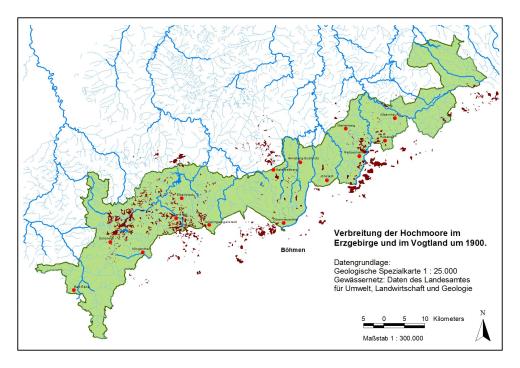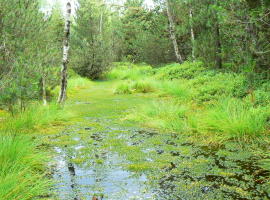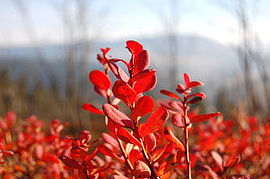You can find more comprehensive information on the following website:

Upland moors originated on the ridge of the Erzgebirge even before the last ice age. They should really be called rain moors as they are almost exclusively fed by rainwater. Annual precipitation of 1,000 millimetres or higher is required for them to develop and grow. Moors are created by peat mosses. These plants are “immor-tal” in that the shoots grow every year while the underground elements die off and, over the course of many centuries, turn into peat.
The characteristic hourglass-shaped bulges of the upland moors are created by this process, with the strongest peat-moss growth at their centre. Most of the moors in the Erzgebirge, like the Großer Kranichsee and the Kleiner Kranichsee, are anticline moors which developed along the mountain ridges. Only a small remnant of the percolation mires of the river valleys remains in the form of the Jägergrüner Hochmoor upland moor near Tannenbergsthal. Many of the nature park’s moors have fallen victim to peat extraction.

Only a small number of plants and animals were able to adapt to the harsh living conditions in this environ-ment. However, they include some very interesting species – such as the carnivorous sundew, two species of which can be found in the nature park. Black grouse rely on these open areas as their traditional mating grounds, which they return to again and again for many years. Areas such as this now only remain on the Schwarze Heide and Kriegswiese moors.

Preserving the last remaining landscapes of what was once “Miriquidi” (the Dark Forest) is one of the nature park’s main development goals, as is regenerating moors that have been exploited for peat, such as the moor near the Reitzenhain peat works. Because they function like giant sponges, the moors are also extremely im-portant for the retention and regulated release of water. During heavy rainfall, the moss cushions absorb huge amounts of water, which is eventually released into the streams bit by bit. The moors can retain most of this water for a long time, meaning that they function as a natural water storage system. Scientific studies and model calculations on the Mothäuser Heide indicate that it has the potential to store over three million cubic metres of water. The moor water has a naturally high humic acid content and as a result a very low pH.
Mountain pines are one notable feature of the Erzgebirge moors. These are a taller variant of moor pines. The most beautiful examples can be found on the Mothäuser Heide. Some moors, such as the Pfahlbergmoor, were almost completely stripped of peat and are now in a regeneration phase.
These areas are of significant importance to botanical science as they provide us with an insight into the moor’s vegetation history. Year after year, enormous amounts of pollen have accumulated (and continue to be deposited) around growing plants in the open areas. Thanks to the high amounts of humic acid in the subsoil, this pollen is conserved for a long time. By using bores to take cores from the peat, scientists are able to analyse and determine the pollen levels for different types of plants at each individual level of growth. This allows them to ascertain the composition of the plant cover during different periods to a relatively high degree of accuracy. Studies like these reveal the secrets of nature’s development since the last ice age.
Further information on the regeneration of the moors in the Erzgebirge/Vogtland Nature Park can be found on the website for the moors revitalisation project Revitalisierung der Moore zwischen Hora Sv. Šebestiána und Satzung at https://moorevital.sachsen.de/
Autor: Brockhaus, Thomas (1997): “Der Naturpark als Wasserspeicher” IN: Unser Naturpark Erzgebirge / Vogtland, Dresden

